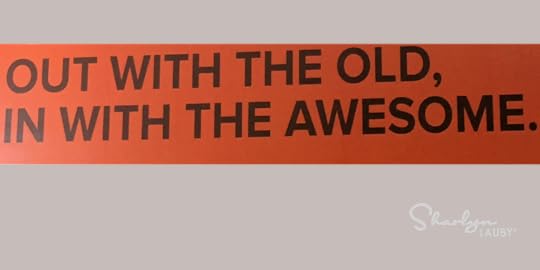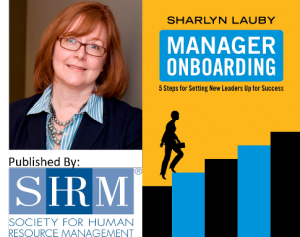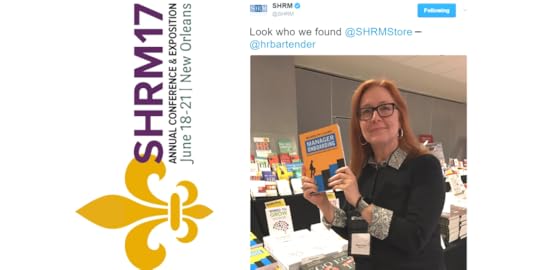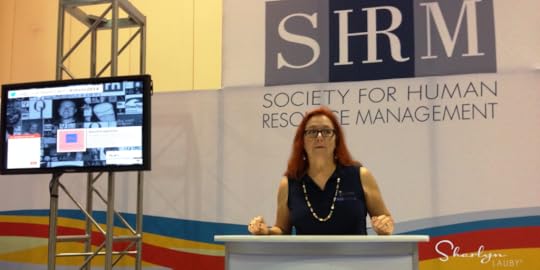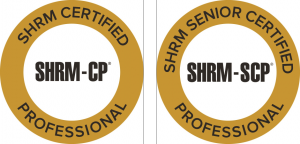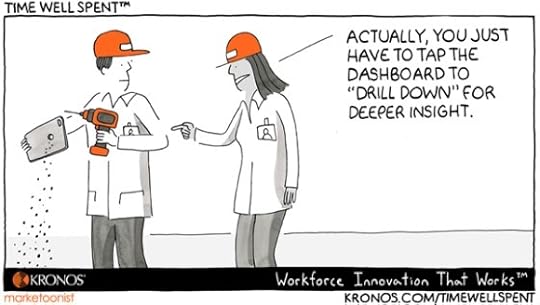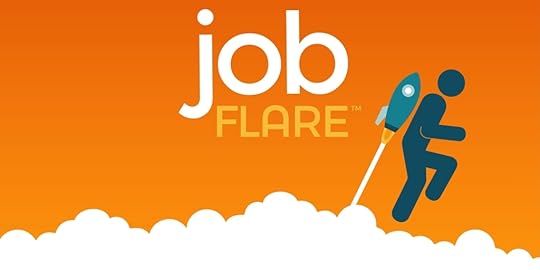Sharlyn J. Lauby's Blog, page 135
June 19, 2017
How Your Small Business Can Attract and Retain Top Talent
(Editor’s Note: Today’s post is sponsored by Massachusetts Mutual Life Insurance Company (MassMutual), a leading provider of insurance, annuities, retirement plans, and other employee benefits. They were recently recognized by the Ethisphere Institute as a . Many congratulations to them. Enjoy the post!)
All businesses face the same challenges. From an operational perspective, every business deals with maintaining product quality, customer service, marketing, technology, and cash flow. Plus, a whole lot more. It’s the same with people issues. Every business is faced with recruiting challenges, employee morale and engagement, retention, training, etc.
As someone who has worked for big businesses and now owns a small one, I feel like we do everything large companies do. We budget, plan, and strategize like any business. However, I know that sometimes it feels like big corporations can fix challenges by throwing money at their problems. Big companies can have more resources at their disposal. It’s true. Some big companies have more resources and they choose to spend those resources to address issues. That doesn’t change the difficulty of the issue. But it can often mean the solution is more readily available.
The Advantages of Being a Small Business
However, when I start thinking about the advantages big businesses have, I’m also reminded of the reasons that we chose to keep our company small. According to the U.S. Small Business Administration, there are 28 million small businesses in America, and they account for 54 percent of all U.S. sales. Small businesses provide 55 percent of all jobs and 66 percent of all net new jobs since the 1970s. And small businesses are growing. Since 1982, the number of small businesses in the U.S. has grown 49 percent.
There are plenty of reasons to start a small business and keep it that way.
Small Business Concerns about Employee Loyalty
I recently got my hands on the MassMutual Business Owner Perspectives Study. It’s a very interesting read worth checking out. While the study covers issues like business valuation and transitioning ownership, I immediately homed in on the section about employee loyalty. Because even though business valuation and transitioning ownership are important, employee loyalty was ranked the number one issue facing small businesses (81 percent).
Interesting, eh? The very same thing that’s keeping the Fortune 100 up at night is disrupting the sleep of small business owners. The question becomes, how can a small company retain employees? In my experience, employees leave for two reasons.
Reason #1 – Their manager.
Employees want to feel that their manager is there to support them. That means managers should set expectations, teach employees what they need to be successful, offer regular coaching and feedback, and give recognition for excellent work.
Small businesses have an advantage in this area because it’s easy for employees to get noticed in the organization. There are fewer organizational layers and employees can build stronger relationships with people at every level of the company. Also, employees can potentially learn more because they are exposed to all aspects of the business, not simply the department they work in.
Reason #2 – Their job.
Employees want to do interesting work. I’ve often heard employees at small companies say they feel more connected to the mission of the organization because they can directly see how their role impacts the bottom-line.
Employees also want to be paid fairly and competitively. This includes their benefits and perks package.
Small businesses can have an advantage here because they don’t typically have all the policies and procedures that larger companies do. So, things that employees like such as casual dress codes, flexible schedules, and working from home could be possible. And many of these things have a low cost attached to them. That’s not to say that big companies aren’t adopting them too – they are. But small businesses often have the agility to quickly expand upon them. They can identify employee wants and needs and adapt their offerings accordingly.
The key for small business owners is understanding what their employees want and developing a plan of action to make it happen. Just because Google employees have a foosball table doesn’t mean your employees want one.
Get Some Creative Inspiration from Others
When faced with a challenge, I’ve always thought one of the best places to start is by getting some creative inspiration from others. Think of it as benchmarking or best practices.
MassMutual is hosting a realBUSINESS™ webinar focused on “How to Overcome the Top Challenges Small Business Owners Face” on Tuesday, June 20, 2017 at 1:00 p.m. Eastern. The highlight of the webinar will be a live question and answer period with small business owners. It’s the perfect opportunity to find out what others are doing. I do understand you might already have plans for Tuesday. If that’s the case, sign up anyway and get the recording.
The webinar is one in a series of realBUSINESS™ webinars for small business owners. You can find more on the MassMutual YouTube channel.
Small businesses can attract and retain top talentClick To Tweet
Small business owners have real advantages that they need to leverage when it comes to attracting and retaining the best talent. There are lots of people who would prefer to work for a small company. Take advantage of the opportunity! Your employees (and future employees) will thank you for it.
The post How Your Small Business Can Attract and Retain Top Talent appeared first on hr bartender.






June 18, 2017
Onboarding: Your Connection Between Recruiting and Learning
We’ve all seen the headlines lately about the U.S. being at “full employment”. On the surface, full employment might sound like a good thing, right?
Well, not so fast. Full employment can create a couple of challenges.
Over inflated compensation and benefits. I’m all for a competitive job market. Top talent should be able to get what they deserve for their skills and experience. However, too much competition can cause employers to throw money at their recruiting problems. I know what you’re thinking, “Is that a bad thing?” I hate to say it, but it can be. Employees don’t want to be underpaid. They also don’t want to be overpaid.
Less turnover. I’m not advocating for high turnover. But some turnover is good for business. It brings in fresh perspectives. In my experience, when recruiting gets tough, organizations might be reluctant to terminate employees for fear that they won’t be able to find a replacement for months. It’s the philosophy that it’s better to work with the devil you know than someone new.
As a result of these “full employment” recruiting challenges, the recruiting and training functions must work together to fill the talent pipeline. Recruiters must be able to tell the organization what roles are better to develop in-house (versus recruit from the outside). Trainers have to do the same thing. Let the organization know what jobs would be better to hire from the outside (instead of developing from within).
In addition, training and recruiting also have to work together to ensure that new hires are set up for success. The way to do that is with onboarding. It’s the intersection between recruiting and training that creates employee success. According to TLNT.com, one third of new hires quit their job in the first six months. And we all know turnover is costly.
When it comes to onboarding, I’m starting to hear more about a format called talent center. The idea is that talent centers are dashboards where employees, managers, recruiting, and training can monitor and measure onboarding progress. Within the talent center are resources and checklists that new hires and managers can use during the onboarding process.
Now, before declaring checklists as evil, hear me out. On some basic level, we all work with checklists on a regular basis. We need them to remind us because we’re not perfect. Checklists can be used to:
Outline what it takes to be successful in a new role (i.e. competencies)
Document compliance requirements
The tricky thing about checklists is making sure they’re used. That’s the difference between a boring, outdated checklist and an interactive talent center. Here are a couple of things to consider:
Employees and managers must be trained on how to use the talent center. Organizations should not make the assumption that everyone knows how to effectively use a checklist. That’s probably one reason that they’re used badly – no one has ever received training. We’re not talking about hours or days of training here. But do provide managers and employees with guidance on how to make the most of the resource.
Regularly survey managers and employees. The other reason that checklists are not used effectively is because they can quickly become outdated. An outdated checklist is worthless. Managers and employees should be surveyed quickly to make sure onboarding resources are current. (And on a side note: training and recruiting should work together to put a maintenance program in place for talent center materials.)
It could make a lot of sense to transform a traditional onboarding process into a talent center, bringing together recruiting, learning, and performance. They key is getting everyone to participate at a high level. That includes HR.
Image captured by Sharlyn Lauby after speaking at the 2016 MBTI Users Conference in San Francisco, CA
The post Onboarding: Your Connection Between Recruiting and Learning appeared first on hr bartender.






June 16, 2017
Quick Shots for #Recruiting and #HR Pros – Boomerang Employees Edition
Over the past couple of weeks, I’ve received several notes about boomerang employees. In a nutshell, boomerang employees are basically rehires. They worked for the organization, left, and have boomeranged back.
It’s a good time to talk about boomerang employees. There’s been a bit of a rise in boomerang employment. I attribute it to the increased challenges in finding talent. The last U.S. jobs report started the conversation about “full employment”. I recently heard a senior vice president of human resources say that the “war for talent” is child’s play. Candidates were showing up for interviews with 6, 7, 8 offers. Organizations have to start thinking about how they will differentiate themselves.
One way is to consider “Adding Boomerang Employees to Your Recruiting Strategy”.
When you think about boomerangs, it might be tempting to only think about employees who leave for another job. First off, not everyone who resigns is unhappy with the company. It’s possible that employees might leave to attend school. Or maybe they’re an intern. It’s also possible that a boomerang could be an older worker returning to the industry at a later point in their career.
I know it would be awesome if employees never left in the first place. Organizations do need to have retention strategies. Turnover does happen. Sometimes though, it can be good for the employee (and the company) to let the employee leave and gain skills they would never have exposure to otherwise. Then the company can welcome the employee back.
A first step in letting boomerang employees know they’re welcome is the exit interview. Use exit interviews as a way to let employees know they can reapply for jobs.
The next step, and a really important one, is then making sure boomerangs actually feel welcome. It’s one thing to say it and another to actually do it. I had the pleasure of discussing the advantages (and cautions) of hiring boomerangs with Joyce Maroney, director of the Workforce Institute at Kronos, and John Hollon, award-winning journalist and talent management expert, during the podcast “Boomerang Employees: Can you Go Home Again?”
Boomerang employees can bring a lot of value back to the organization. They already know the company’s strengths and weaknesses. The one thing that must be resolved is the reason for the employee’s departure. Will the same annoyances happen again? The employee and company need to have their eyes wide open and discuss matters honestly.
Image captured by Sharlyn Lauby somewhere on the back trails of Walt Disney World, FL
The post Quick Shots for #Recruiting and #HR Pros – Boomerang Employees Edition appeared first on hr bartender.






June 15, 2017
How to Create Learning Paths that Align with Company Goals
A learning path is a sequence of activities that allows a person to build knowledge or skill. For instance, an employee who wants to become more proficient in project management might have a learning path that includes: proposal writing, budgeting, scheduling, critical evaluation, and project management. The idea being that each topic builds upon the previous and makes the employee better at project management.
Learning paths are different from talent pools, in my opinion. A talent pool is often used as an alternative to succession planning. Organizations that aren’t ready to make the definitive statement “We’re grooming Leonard to be our next chief financial officer.” can instead identify future talent needs and provide career development opportunities.
And that’s the difference to me. Learning paths address the organization’s current needs and talent pools take more of a future approach. Any employee can have a learning path. In fact, every employee probably should have a learning path. And an employee’s learning path should help them achieve their goals.
I’m a fan of cascading goals. The idea that the organization’s goals are the department’s goals. And the department’s goals are employee’s goals. It all flows downhill…in a good way, of course. The idea being that if companies want to achieve their goals then employee goals should be aligned. Employees should understand how their goals help the company accomplish their strategy.
So how do companies create learning paths? Consider these six steps.
Educate employees on how to develop relevant goals. Employees need to know not only how to state the end result (i.e. the goal) but outline the individual steps toward accomplishment. They also need to know how to establish priorities along the way.
Train employees on self-learning. For learning paths to really become a part of organizational culture, employees need to buy into them. That means emphasizing from hire to retire the concept of learning. Being a lifelong learner isn’t some trend du jour. It’s how individuals and businesses stay competitive.
Use SMART to develop learning action plans. You guys know I’m a big fan of the SMART acronym (specific, measurable, actionable, responsible, time-bound). One of the reasons is because, once you learn it, it’s very adaptable. Teach employees how to use SMART and they can create their own learning paths.
Allow employees to learn using different learning styles. In #2, we talked about self-learning. Part of self-learning is having a self-awareness of how someone likes to learn. In addition, knowing when to push ourselves outside of our comfort zone and learn a different way because it will benefit us in the long-run.
Create an environment that encourages feedback. All learning involves feedback. The feedback might occur before, during, or after the learning takes place. The goal of feedback is to improve performance. Train employees at every level how to deliver feedback to their peers and their manager.
Allow employees to fail. This is probably the toughest part of a learning path. Organizations have to be willing to let employees make mistakes…and learn from them. Managers should play the role of coach and truly help employees learn from missteps.
Learning paths can provide employees with educational opportunities to achieve their goals. When employees achieve their goals, organizations can accomplish their goals and strategies. But it means that organizations must make an investment in training – at the employee and manager level – so learning thrives.
Image captured by Sharlyn Lauby after speaking at the SHRM Annual Conference in Las Vegas, NV
The post How to Create Learning Paths that Align with Company Goals appeared first on hr bartender.






June 13, 2017
Give Your New Managers the Tools to Succeed
Managers have one job – to find and train their replacement.
When managers are focused on that one job, they hire the best talent, train for success, coach for high performance, and retain employees. They can take a vacation or attend a conference with confidence, knowing that the department isn’t going to fall apart. Managers who are focused on their one job can participate in that super-secret special project that will get the attention of senior management. They can do cool stuff that will enhance their skills and knowledge.
Managers who focus on finding and training their replacement aren’t dispensable. They’re promotable. And, organizations that want managers who will hire, train, and retain the best talent need to set those managers up for success.
Unfortunately, many organizations hire or promote the most technically competent person into management. The new manager gets training on-the-job, which isn’t bad. On-the-job training can be very valuable. But too often on-the-job training happens after the new manager makes a mistake. A mistake that could have been avoided if the new manager had received proper training in the first place.
One way to give a new manager the tools they need for success is with onboarding. Think about it – companies currently provide onboarding to new hire employees. Why not onboard new managers?
I believe onboarding managers isn’t the same as management or leadership development. Those programs offer skills that employees can use immediately like communication skills, decision-making, and problem-solving. A manager onboarding program includes skills that managers need the minute they become a manager such as workforce management and employment law. There’s a place for all of these programs.
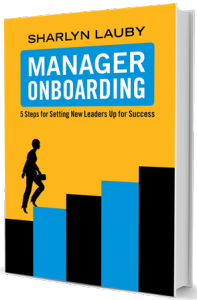 Creating a manager onboarding program doesn’t need to be expensive or time-consuming. In fact, I have a resource that can help. “Manager Onboarding: 5 Steps for Setting New Leaders Up for Success” is a practical guide for designing and implementing a manager onboarding program. It’s available at the SHRM Store (and on Amazon!) I’ll be signing copies on Sunday, June 18 during the Society for Human Resource Management (SHRM) Annual Conference and Expo in New Orleans. I hope you’ll stop by and say hello!
Creating a manager onboarding program doesn’t need to be expensive or time-consuming. In fact, I have a resource that can help. “Manager Onboarding: 5 Steps for Setting New Leaders Up for Success” is a practical guide for designing and implementing a manager onboarding program. It’s available at the SHRM Store (and on Amazon!) I’ll be signing copies on Sunday, June 18 during the Society for Human Resource Management (SHRM) Annual Conference and Expo in New Orleans. I hope you’ll stop by and say hello!
Your manager is an important part of your organizational success. Give them the tools to meet their goals. Starting with Day One onboarding.
The post Give Your New Managers the Tools to Succeed appeared first on hr bartender.






June 11, 2017
SHRM Certification: You Can Get More Than 60
You might be looking at today’s post and thinking “What is the ‘60’ she’s talking about?”. Well, I’m referring to the number of recertification credits required to maintain credentials with the Society for Human Resource Management (SHRM). To me, recertification is the most important part of the SHRM certification process because it reinforces a commitment to continuous learning about human resources competencies.
If you’re not aware, SHRM-CP and SHRM-SCP credential holders must earn sixty (60) professional development credits (aka PDCs) within a three-year period. Or retake the exam.
Many certified professionals do opt to retake the exam as a way to recertify. I get it. Retaking the exam allows a person to participate in the rigor associated with studying and preparation – which I admit is challenging. But I also know that not everyone will want to follow that path.
As a SHRM-SCP, one of the things I do is turn the process of recertifying into a game. What I mean by that is I set goals for myself. For example, it’s always a goal of mine to get recertification points in each of the three PDC categories.
Advance Your Education – continuing education including conferences, seminars, eLearning, webinars, etc. It also includes programs held at local SHRM chapter meetings and reading HR books that have been pre-approved for credit.
Advance Your Organization – work projects that support organizational goals like designing a training program, revamping the company’s performance management program, and implementing a new technology solution.
Advance Your Profession – volunteer activities and thought leadership that contribute to our profession such as professional membership, speaking at events, and writing (including writing on blogs!)
In fact, to add a little extra challenge, I use the SHRM Recertification Handbook to set goals within each category. For example, under advance your education, I might include:
Attend one webinar program a month
Listen to one podcast each week
Read one HR book for credit each quarter
The reason I’m mentioning my recertification goal-setting process is because, even though the requirement is 60 credits, we shouldn’t stop learning once we’ve entered 60 PDCs. It might be tempting to say, “Whew! I’m done. I’ve got my 60 credits.” The truth is we still always have learning to do. We can’t make decisions about our professional development based on the number 60.
In addition, we shouldn’t stop tracking our professional development once we fulfill our “60” obligation. We can use our recertification documentation for more than PDCs. It might be something to share with your boss. Or use in developing a competency.
The SHRM Certification team has made it very easy for us to keep track of PDCs with their app (FREE on iTunes and Android). The app allows you to enter PDCs as you earn them. According to Cornelia Springer, director of SHRM certification services, people are enjoying the app. “Of the 52,000 individuals due to recertify in 2018, 12 percent have entered 60 or more PDCs. We attribute some of that to the ease in online and mobile tracking.”
Getting and maintaining a certification isn’t easy. On some level, it’s supposed to be challenging. But we can’t confuse our certification with our professional development. To stay relevant in our careers, we need to be learning all the time. That can make the process of recertifying a piece of cake.
Image of Sharlyn Lauby captured during her SHRM Annual Conference presentation in Orlando, FL. SHRM Certification seals used with permission.
The post SHRM Certification: You Can Get More Than 60 appeared first on hr bartender.






June 9, 2017
Don’t Overthink Your Data – Friday Distraction
The purpose of collecting data is to take some action using the data. And, taking action is often one of the most challenging steps in any type of data collection process. Obviously, it doesn’t make sense to collect data and not do anything with it. Taking action is implied. The data might help us make a decision, notice a trend, or monitor our effectiveness.
But when we get lots of data, it can be tempting to spend ridiculous amounts of time studying it. Today’s Time Well Spent from our friends at Kronos is a reminder that sometimes technology can help us analyze the data. So, we don’t need to overthink it.
To avoid overthinking the data (sometimes known as “analysis paralysis”), consider these three things:
Have a target in mind. I often think that this step isn’t given enough attention. There’s a reason that the data is being collected in the first place. It might be to understand where the best recruiting sources can be found. Or how to schedule employee coverage that meets customer needs. Before getting into the weeds with data, understand the goal of collecting the data.
Realize you might never have all the data. Alas, as much as we love technology and its capabilities, we need to cut technology some slack. Technology is only as good as the data we give it. Which means, if we give our systems incomplete information, we should expect incomplete data analysis. The good news is that we can identify these empty pockets of data and figure out how to fill them.
Be okay with making a wrong decision. I’ve worked with a couple of people in my career who thought the way to never make a wrong decision was by never making a decision. Simply not true. One of my favorite quotes from John F. Kennedy says it best. “There are risks and costs to action. But they are far less than the long-range risks of comfortable inaction.”
Data brings tremendous value to business. But only if we do something with it. Overthinking the data can stop individuals and organizations from moving forward.
The post Don’t Overthink Your Data – Friday Distraction appeared first on hr bartender.






June 8, 2017
Increase Employee Engagement and Retention with Better One-on-One Meetings
One-on-one meetings between managers and employees have always existed. However, they are getting much more attention lately. I believe a big contributor is the focus on continuous performance management. Which makes sense. Why not use regular communication as a way to strengthen performance.
Organizations need to remember that the one-on-one meeting becomes successful when managers and employees have a good meeting. I know, this sounds basic, but when we read about all of the unproductive meetings that take place, it’s doesn’t make sense to assume that managers and employees know exactly what to do in a one-on-one meeting.
If organizations want managers and employees to have productive one-on-one meetings, they should offer some training and guidance on how to conduct them. And not just for managers. Employees are 50 percent of the meeting. They need training too!
Over the past couple of months, I’ve been working with our friends at Saba Halogen to outline the elements of a successful one-on-one meeting. I hope you’ll take a moment to check these posts out. Bookmark the page. Socialize it around the office.
A Manager’s Guide to Successful 1:1 Meetings with Employees
An Employee’s Guide to Successful 1:1 Meetings with Your Manager
These two posts share a blueprint to prepare for a one-on-one meeting. You can use it as creative inspiration for a microlearning session. It can be turned into a meeting agenda. The goal is to get managers and employees to start scheduling, planning, and participating in productive meetings. Because when they do, the organization wins.
Regardless of your company’s views about the annual performance review, managers and employees need to have regular conversations. And the conversations need to be good. The result will be trusting relationships, employee engagement, and retention.
Image captured by Sharlyn Lauby after attending the Great Place to Work Conference in Austin, TX
The post Increase Employee Engagement and Retention with Better One-on-One Meetings appeared first on hr bartender.






June 6, 2017
Job Seekers: Use Games to Find Your Next Job
(Editor’s Note: Today’s post is sponsored by Criteria Corp , a leading provider of pre-employment testing services. Their testing system, HireSelect, is a SaaS (software as a service) solution that enables organizations to increase recruiting effectiveness using state-of-the-art technology. Criteria Corp has clients in all 50 U.S. states and 30 countries. Enjoy the post!)
Let’s face it. Looking for a new job isn’t always fun. It takes time to send out your resume out to lots of companies (aka “spray and pray”.) It involves waiting. Lots of waiting. So, what if I told you that it was possible to have a bit of fun while trying to find a new job?
Our friends at Criteria Corp have launched an app called JobFlare (iOS, FREE) that allows users to play “brain games” that are scientifically created to test the cognitive abilities that every employer wants AND are considered the key predictors of job success. Let me explain how the app works.
Cognitive Ability Correlates with Job Success
I don’t want to get too far into the weeds, but there is scientific research spanning the course of almost a century on the predictive validity of hiring methodologies. The research has found that cognitive aptitude is one of the most predictive factors of job performance, just after work samples (which is obviously hard to beat). So JobFlare allows users to play games that are highly correlated with cognitive aptitude tests, which have been consistently proven as one the most predictive factors of job success.
JobFlare offers six games. Each game in JobFlare takes 90-seconds. Users can play the games as much as they like.
Math games (Infruition, Weigh Station)
Verbal games (Words of a Feather, Mumble Jumble)
Mental Fitness games (Robot Inspector, Expert Witness)
While JobFlare isn’t designed to improve cognitive function, Criteria Corp did share with me that candidates who are playing the games can regularly improve their scores. I believe using brain games in this way could reduce or eliminate some of the common apprehensions about job-related test-taking like “I was nervous so I didn’t do my best.” Or “If I could take it a second time, I’d do better.”
In my experience, employers really aren’t looking for employees to be perfect on a test. They do want employees who can think, reason, and improve with practice. And it’s important to note, employers don’t have direct access to see scores, so if a person starts out with a lower score, they don’t need to worry about anyone seeing them.
JobFlare Partnership with ZipRecruiter
Josh Millet, CEO of Criteria Corp, says that JobFlare takes the best of gamification to help users find a job. “Brain games are already a popular activity on smart phones. JobFlare uses games to measure the specific cognitive traits – problem-solving, learning ability, critical thinking, and attention to detail. These traits have been shown to best predict work outcomes and are coveted by most employers. We’re excited to partner with ZipRecruiter to deliver relevant job postings to JobFlare users.”
Here’s how the job posting feature works. Once an individual starts playing games, they can set up a user account including the job positions and industries they have an interest. Play all the games as many times as you want. After you play at least one of each game, you will start to receive email notifications from ZipRecruiter based on the information you provided. Now, let me offer a couple of caveats:
Please remember that every job in the universe isn’t posted on ZipRecruiter. That’s not a ding against them. They have thousands of job postings. But there’s no one site with every open job.
I talked with the JobFlare app developers and they gave me a high-level overview of how the job posting algorithm works. Basically, the emails start out very broad – meaning you will see lots of jobs – and get more focused over time based on the job openings you express an interest in (i.e. the ones you click on to learn more).
Flexibility Sets JobFlare Apart
I’ve been test driving this app for a few weeks and the thing I really like is its flexibility. When we’re looking for a job, we need to be flexible and the app provides it. JobFlare users can engage with one or both parts of the process as you wish.
If you want to play the brain games and receive job postings, great!
If you want to just play the brain games but aren’t ready to receive job postings, fine!
And if you want job postings but don’t want to deal with the brain games, that’s okay too!
Some of you might still be wondering about brain games, cognitive ability, and validity. Criteria Corp also offered to send me the nitty gritty correlation coefficients and more, but as much as I love statistics, I didn’t really think it was necessary. I did ask Millet to set the record straight about brain games. “Let’s be clear: our games aren’t designed to be ‘brain training’ games, they are gamified ways to measure cognitive aptitude. No doubt they do play a role in sharpening your skills a bit, but they don’t increase your cognitive abilities. We designed the games with this in mind – all of our games are strongly correlated with our cognitive aptitude tests, which are designed specifically to predict job performance. We believe JobFlare represents a unique vehicle for connecting undiscovered talent to opportunity.”
Job Seekers: Use Games to Find Your Next JobClick To Tweet
Adding a Few Fun Games to Your Job Search Isn’t a Bad Thing
While anyone can use JobFlare, it’s an ideal app for professionals at the beginning of their career, people considering a career or industry change, and individuals looking to downsize their work commitments (i.e. retirement). It provides an opportunity for self-awareness and education, which is always a good thing. Check out the JobFlare iTunes page for more details and to download the app.
The post Job Seekers: Use Games to Find Your Next Job appeared first on hr bartender.






June 4, 2017
Organizations Need to Expect Turnover
Organizations are focused on retention. And that’s a good thing. Obviously, turnover is expensive – both in terms of cost and knowledge loss.
However, it’s unrealistic to think that turnover won’t exist. So, organizations need to think about what amount of turnover is going to be acceptable. Employees are going to stay for a few years and then move on. Employees are going to retire. All of that is okay. All turnover isn’t bad turnover. But there are a few things that are important to remember about turnover:
Former employees are a reflection of your organization. People take their employee experience with them for the rest of their professional lives. Organizations have to decide if they are going to let a person take a good or not-so-good experience with them.
People are asked about their careers all the time. When they get asked, the response can be focused on the challenging work, the learning environment, and the collegiate teams OR it can be a curt “it was fine”. We both know what the latter means. The way a person views their employee experience has an impact on other things.
Former employees might want to come back – either in a full-time or freelancer capacity. Individuals might find that the grass isn’t always greener at another organization. They might also spend a few years acquiring skills that they couldn’t get inside the organization and be in a great position to boomerang back.
Organizations can also find themselves in the position of needing a niche skill that a former employee was tremendously good at. The former employee might be willing to do some work for the company on the side. Employees aren’t going to be receptive to returning – even in a freelancer role – if they had a poor employee experience.
Former employees can refer candidates and customers. If an individual has a poor employee experience, I believe they will hesitate to tell their friends to apply for work with the company. It’s similar to customer referrals. I don’t tell my friends to eat at restaurants where I’ve had a bad meal. Why would I tell one of my friends to apply someplace where I’ve been treated poorly?!
Surveys show that a poor customer experience has an impact on the business. It seems logical that a poor employee experience will do the same thing.
I don’t know that any of these concepts are new. Former employees have always had the ability to talk about their past employers and refer others. But I do believe the emphasis on the value of the relationship is changing. In the past, maybe organizations didn’t focus on it as much. But now, with unemployment being low and the challenges finding qualified candidates, it’s time to realize the relationship cannot be ignored. In fact, it’s quite the contrary.
Organizations need to realize that the employee/employer relationship lasts well beyond the time that the employee works for the company. They need to think about it and strategize about it in ways similar to the candidate experience. The employee experience is important and has an impact on the bottom-line. Not only when the employee is working for the company, but for years after.
Image captured by Sharlyn Lauby after speaking at the Learning and Development League 2016 Annual Conference in Delhi, India
The post Organizations Need to Expect Turnover appeared first on hr bartender.






Sharlyn J. Lauby's Blog
- Sharlyn J. Lauby's profile
- 10 followers



